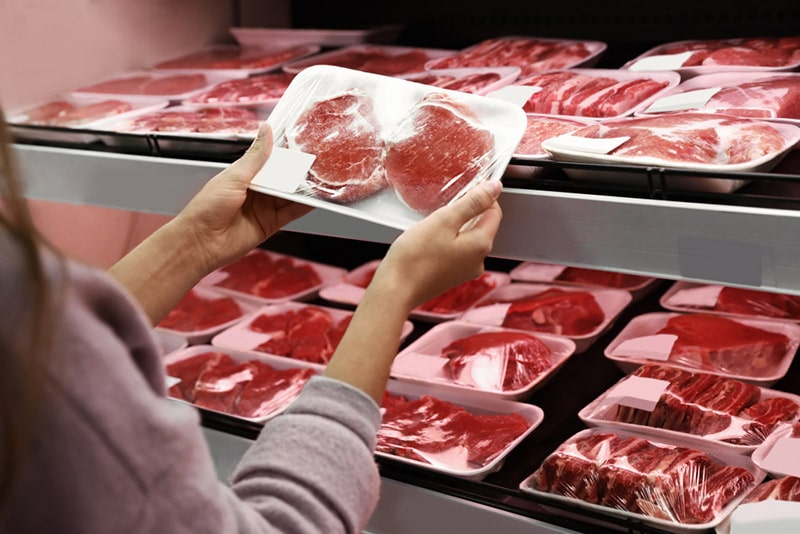
Cats can’t live without meat. As obligate carnivores, felines require meat in order to receive essential amino acids such as taurine, that their bodies can’t produce on their own. In the wild, cats kill small prey such as mice to survive. To your dismay, your domestic cat might even carry this tradition forward as they bring you their trophy carcasses of lizards and small birds. It’s unlikely that modern house cats kill out of necessity, but it seems that their hunting instincts followed them into domesticity.
Since cats obviously don’t have ovens, all the meat they kill is eaten raw. At first glance then, it seems like raw meat such as pork would be perfectly safe for cats to eat. After all, isn’t natural always best? Well, not quite and cats shouldn’t eat raw pork. Let’s talk about the differences between the poor bird your cat targeted from the porch swing and the slab of pork sitting in the case at your local supermarket, to determine the answer.
Is Raw Pork Safe for Cats?
Commercially produced raw meat always carries a risk of food-borne illness. This is why rare steak and sushi generally aren’t recommended for pregnant women, or people with compromised immune systems. Pork particularly carries extra risks that are more common to that species, such as trichinosis. This parasitic nematode can cause muscle pains, weakness, and even death, depending on the extent of the infestation. Trichinosis is easily transmittable to humans, but treatment is more readily available for us than it is for felines. Fortunately, there is a sure-fire way to prevent your cat from contracting Trichinosis, and that is to not feed them raw pork.
Trichinosis is now rare in humans. According to the CDC, there are only about 16 reported human cases in a year, which is significantly lower than the numbers were during the mid-20th century. However, animal infections are often asymptomatic, so the incidence is likely to be much higher in cats.

What About Raw Meat Diets?
Considering the risk of trichinosis and other food-borne illnesses, it’s safe to conclude that feeding your cat raw pork is a bad idea. So what about the growing popularity of raw diets? One could certainly argue that cooking meat reduces its nutrient value, particularly when we are talking about the high-pressure, high-temperature process used with many commercial pet foods. Equally, raw meat alone will not provide all of the nutrients your cat needs to thrive. If you choose a raw food formula, make sure it’s AAFCO-approved to guarantee they’re eating a balanced diet.
All raw meat carries some risk of foodborne pathogens such as salmonella and listeria. Trichinosis isn’t very common in other meats, however, so pork is the one to avoid there. Although there are some guidelines that can help improve the safety of feeding raw pork, the risks certainly outweigh the benefits.

What About Cats in the Wild?
Here’s the main difference between raw meat in the wild and the type that’s sold in your supermarket or used in raw pet food: it’s fresh and unprocessed. Unless the animal caught is infected with pathogens, there is no opportunity for any of these food-borne diseases to infect the meat.
Processed meat poses more of a risk for food poisoning in general, because of the time between slaughter and serving; it can often take between 5-15 days for meat to go from the slaughterhouse to the supermarket. Grounding raw meat exposes more of the surface area to air, which increases the chances for bacteria to enter, so raw mince poses the highest risk of food borne pathogens.
Commercially prepared raw food diets are processed for safety, but unless they’re frozen at the appropriate temperature for the right amount of time, they also pose a health risk for you and your cat.
Knowing exactly what your feline companion can and cannot eat will help you become the best pet parent. Recognizing that not all cat bowls are equal is also key! The Hepper NomNom Cat Bowl sets itself apart from traditional options by catering to the specific needs of cats. The innovative design offers whisker relief via shallow dishes and promotes digestion with a slight bowl elevation. Find out if the Hepper NomNom is right for your cat by clicking here.
At Pet Keen, we’ve admired Hepper for many years and decided to take a controlling ownership interest so that we could benefit from the outstanding designs of this cool cat company!
Conclusion
Although cats eat raw meat in the wild, it’s not the same as the meat in a raw food diet. Meat that’s been freshly killed is less likely to carry pathogens than meat that was slaughtered a couple of weeks ago. The so-called benefits of raw food diets are so far unsubstantiated, with no reliable studies proving that they are more nutritious than regular commercial foods, but they certainly carry a higher risk of foodborne illnesses and parasites.
As a high-risk for trichinosis, which can easily be transmitted to humans, we do not recommend feeding raw pork to your cat. If you do decide a raw diet is right for your cat, make sure it’s AAFCO-approved and stays frozen for at least three weeks before you let it thaw. It is also important to ensure your cat is up to date with worming treatment. Clean and disinfect any surfaces it comes in contact with, and don’t let your cat lick you to reduce the risk of illnesses spreading to you.
See also:
- Can Cats Eat Pork? Vet-Reviewed Facts & Safety Guide
- Can Cats Eat Raw Meat? Vet-Reviewed Nutrition Facts & FAQ
Featured Image Credit: mp1746, Pixabay







